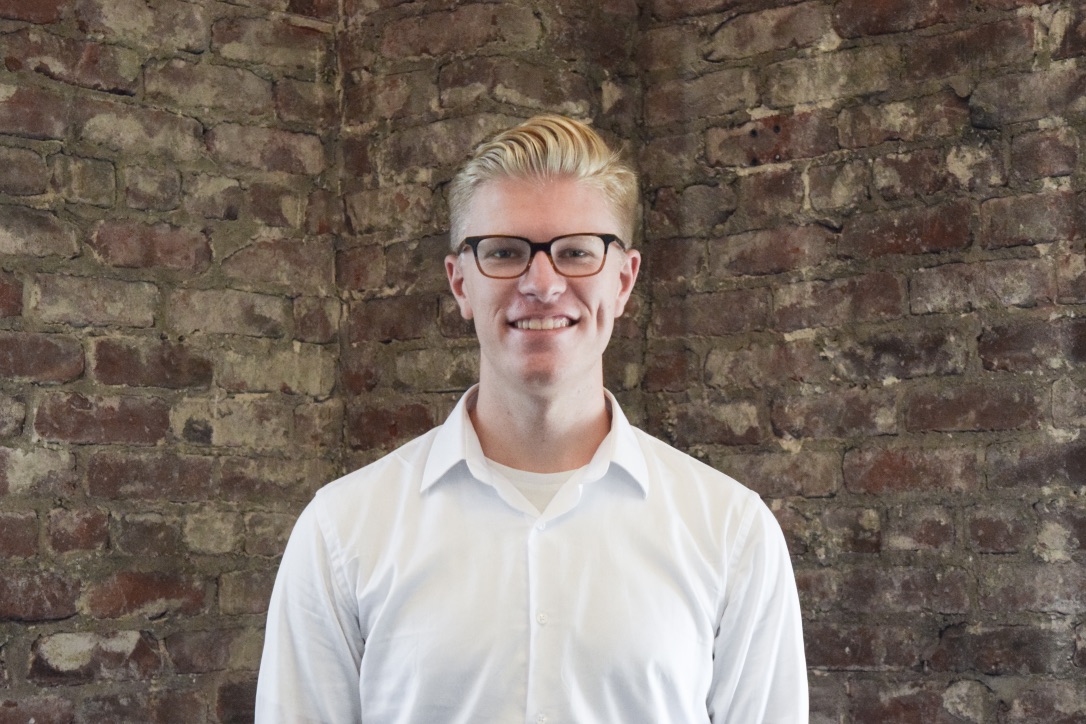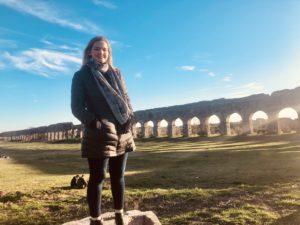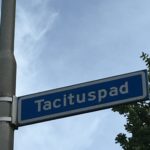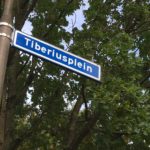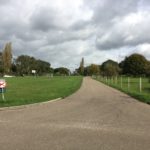On October 6, 2020, Dr. Anthony Fauci ’62, the director of the National Institute of Allergy and Infectious Diseases and a Classics major while at Holy Cross, spoke with current students about the COVID-19 pandemic, the benefits of his liberal arts education at Holy Cross, and much more. See the recording of the conversation below.
Classics alum Anthony Fauci ’62 discuses the COVID-19 pandemic & his time at HC with current students
Alum blog post: From Latin, Greek, and Manuscripts to Engineering Software
Alex Simrell ’16 lives in the San Francisco Bay Area and works as a software engineer for Grokker. While a student at Holy Cross, Alex spent a semester abroad in Athens, and served in his senior year as the president of the Manuscripts, Inscriptions, and Documents Club.
Classics majors are often asked, “Why are you studying a dead language?”, “What will you do with that?”, or something along those lines. For me the answer was simple: I wanted to be a Classics teacher.
I delayed entering the teaching profession and accepted a Fulbright research grant to work on the CroALa project, a digital collection of Croatian Neo-Latin texts. In Croatia I became fascinated with the technical side of my research, and afterwards completed an intensive three-month “programming bootcamp.”
Now three years into my career as a Software Engineer, I have a new appreciation for my Classics background. Computer languages are more similar to Greek and Latin than you might think. When learning to code, the focus is primarily on reading and writing. First you need to learn the vocabulary and rules of the language. Then you use that knowledge to construct sentences or lines of code to state an idea. Finally you put those ideas together to express something more complicated. You need to balance understanding the big picture with paying attention to the smallest details (computers are not very forgiving)!
The skills I developed as a member of the Manuscripts, Inscriptions, and Documents club have been especially applicable. Although I did learn technical skills that are very useful, the non-technical skills have been even more helpful so far. Many people imagine programmers writing code alone in a dark room, but in reality code is written by teams. Strong communication is crucial. Presenting my MID research to Classics people without a technical background and technical people without a Classics background prepared me well for communicating with other software engineers as well as non-technical business people.
I believe that the point of a Classics education is not to learn specific content knowledge, but to build a foundation for future learning. My Classics background provided me with a strong foundation for Software Engineering, and I’m so grateful for the opportunities it has given me.
Maia Lee-Chin ’21 to study the reading of the Iliad in Worcester schools as the College’s 2020-21 Fenwick Scholar
Rising senior Maia Lee-Chin ’21 has been named the 2020-21 Fenwick Scholar and will be undertaking a year-long senior thesis project titled “Classics in the Classroom: Retelling the Iliad in Worcester.” Maia, one of the Bean Scholars in the Class of 2021, is a Classics major with a minor in Education.
Maia’s proposal focuses on how Classics can engage with elementary age students’ reading motivations to read non-fiction texts. She is interested in two different perspectives: Classics and Education. In Classics, her interest lies in the lack of access for marginalized people (low-socioeconomic status and underrepresented minorities) to the study of Classics. In Education, it is the motivation of early elementary-age children to read informational texts. These two topics have never been discussed in relation to one another, and by studying both of these, schools and colleges alike can better understand the pedagogical effects that Classics has on children’s motivations to read.
Maia aims to reveal the effects of early exposure to Classics on a) the motivations of marginalized children to read and b) the volume of informational texts read. She proposes that a common solution can help to address both problems. A curriculum, aimed at ages 6-8, provides access to marginalized children and can act as a catalyst for students to begin reading more informational texts.
In the Fall 2020 semester, a randomized control study will track the students’ reading by type of text and length of reading. In the Spring 2021 semester, a curriculum centered around the Iliad will be introduced to one classroom and its effectiveness as a catalyst to read other informational texts will be measured. Maia argues that both the lack of access to Classics and the types of texts that students choose to read can be studied by introducing Classics to elementary-age students.
Her advisors for the project are Professor Lauren Capotosto from the Department of Education and Professors Mary Ebbott and Dominic Machado from the Department of Classics. They have worked with her for the past year to craft a proposal submitted to the Fenwick Scholar Committee and the Provost of the College.
Of the educational aims of the project Prof. Capotosto said, “Maia has skillfully woven together her interests in classics and education to design her project, ‘Classics in the Classroom.’ Introducing elementary students to the classics has the potential to build students’ background knowledge and enhance their engagement with reading. Her project is not only well-informed by the research literature, but also feasible for schools to implement. Maia’s work has the potential to meaningfully impact instructional practice beyond the year-long study.”
Prof. Ebbott said of Maia’s engagement with Homer, “No one I know reads the Iliad like Maia. She finds deep personal connection to the story of Achilles’ anger and the war at Troy while also casting an intensely critical eye on the poetry and the ways in which it has been received and taught. Through that combination, she asks questions that are startling and creative in the dual sense of being both imaginative and productive.”
In commenting on the significance of the project Prof. Machado said, “The work that Maia is doing and plans to do is a living embodiment of the Holy Cross mission. It considers ‘the moral character of learning and teaching’ and explicitly asks about ‘our special responsibility to the world’s poor and powerless.’ It is a work of service that seeks to share Maia’s privilege as a college student and a scholar of Classics with marginalized communities right outside our gates. Most importantly, her proposal is the result of years of contemplating the ambiguity and uncertainty that comes from being a member of an underrepresented group in an exclusionary field.”
The official announcement by Ellen Perry, Professor of Classics and the Director of College Scholar Programs, is included below.
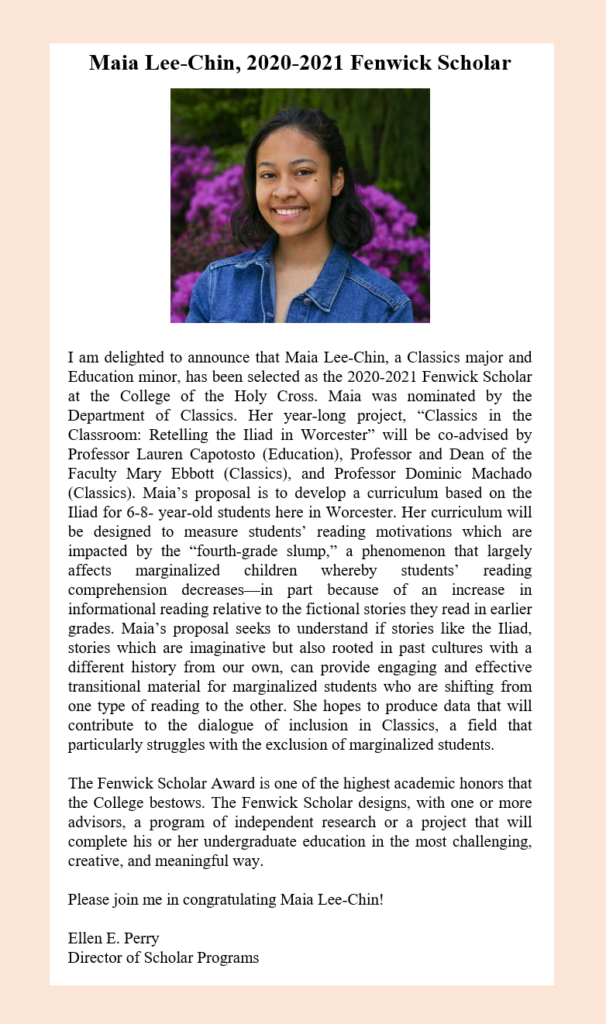
The New England Classical Journal now hosted by Holy Cross’ Crossworks
The New England Classical Journal, a publication of the Classical Association of New England, has moved onto a digital platform through the Holy Cross database Crossworks. Click here for the journal’s new home on Crossworks.
Professor Aaron Seider of Holy Cross’s Department of Classics is serving as the journal’s editor-in-chief, and Anne-Catherine Schaaf ’22 and Smarika Suwal ’22 are working as editorial assistants.
The journal is peer-reviewed and offers scholarly articles, pedagogical essays, and book reviews, all of which explore a variety of topics throughout the field of Classics. The journal’s content is now fully open-access.
Alum Blog Post: Studying the Classics as Pathway to Understanding and Liberation
Meredith Coolidge ’19 is teaching English and tutoring Latin at the Young Men’s Leadership Academy at Wheatley in San Antonio, TX, through the Teach for America program. At Holy Cross Meredith was a double-major in Classics and Political Science, and in 2018-19 she served as Student Government Association Co-President.
The classics major at Holy Cross is distinct because of its Jesuit affiliation. I was fortunate to take classes with professors and on course material that encouraged me to unlearn or see differently many of the ways the classics has been applied throughout history. By the end of my college career, I found myself reading the classics from a new perspective, namely, “How does this inform how I am becoming a person for and with others?”
Through Teach for America, I was placed in San Antonio, TX as a high school teacher at a Title 1, all-boys, public charter academy. Our school is located on a historically-black campus named for famous classicist and poet Phillis Wheatley.
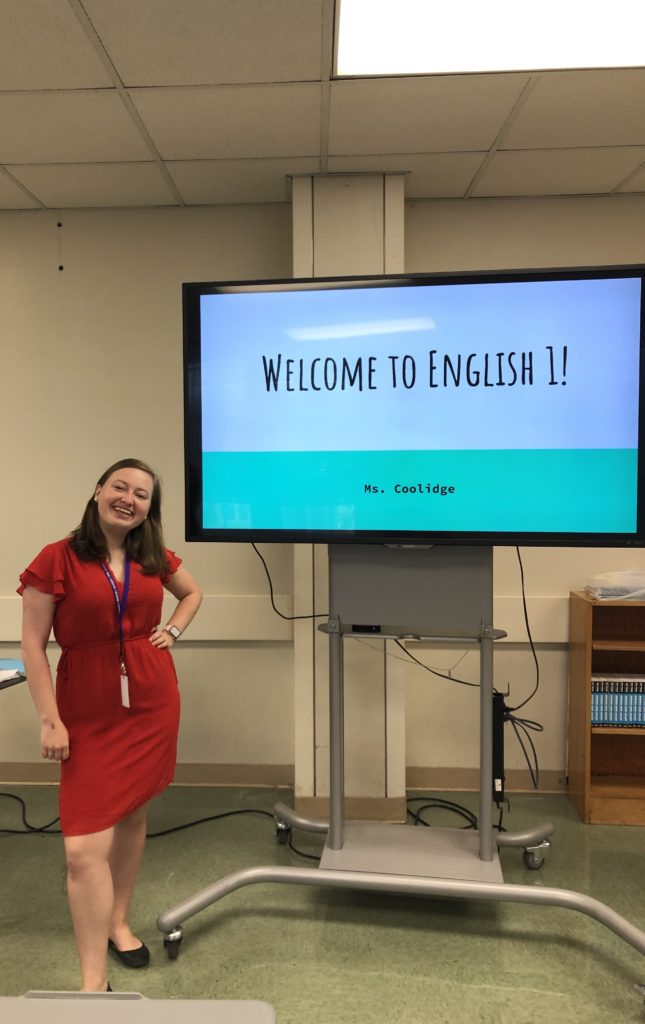
Studying Latin is especially useful for my English Language Learners. I acquired an ESL certification because most of my students speak Spanish, and Latin has been a helpful way to contextualize commonalities between the Spanish and English languages. It also helps my students, most of whom will be the first in their families to graduate from high school, stand out with rigorous course loads as they consider applying to colleges like Holy Cross. I don’t know if there is anything more substantial to set up students for the rigor of a college education than requiring Latin beginning in middle school.
As an English teacher/Latin tutor, I try to find ways to make Latin “cool” and “relatable” (and not just because my kids perhaps ironically call me Ms. Cool). We’ve played word games with Latin prefixes, read mythology, and applied Latin syntactical principles to better understand the functions of English words, which has already improved my kids’ writing and reading comprehension. Explicitly teaching a critical subject (a core, state-tested one) but having a Classics background has helped normalize taking Latin for my students and colleagues.
I did not anticipate my Teach for America experience to be so profoundly influenced by my undergrad major, partially because before I left Holy Cross, I didn’t always see the link with liberation that I see now. I’ve realized my favorite classics courses at Holy Cross were ones in which I saw strong female characters or read texts I could relate to; I am hopeful that by framing characters in classical texts as liberators, my students can see themselves in the Ancient World. The themes in classical texts can be mostly universally applied to contemporary human experiences. It might be a stretch, but focusing on such commonalities in our shared human experience could help heal our increasingly polarized modern world.
Richard Ciolek ’20 on a summer dig in Cosa
After gesticulating with an umbrella and squalling various clucking noises in order to scare a flock of birds into the path of an oncoming Nazi warplane, Sean Connery in Indiana Jones and the Last Crusade, visibly cheerful that his shenanigans brought down the enemy, walked along the beach as the plane smoldered in the background and declared: “I suddenly remembered my Charlemagne. Let my armies be the rocks and the trees; the birds in the sky.”
I was privileged enough to have a few of those “I suddenly remembered my Charlemagne” moments this summer. Like Connery’s character, I don’t leave the library much save the rare occasion to obtain subsistence and attend lectures on historical languages. I, however, had the absolute privilege of digging at an archaeological site this summer at the ruins of Cosa in Italy, where I was able to gain a further understanding of material culture. It was a place, moreover, where I could connect what I had found in the earth to something I read in the classroom.
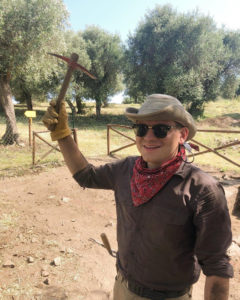
Cosa, the ruins of which are in the extreme south of Tuscany and about two hours north of Rome, was a Latin colony founded around 273 BCE. The site received additional settlers around 197 BCE—perhaps, as the archaeologist Elizabeth Fentress has suggested, due to a shortage in manpower as a result of the Second Punic War. Further expansion occurred later in the second century, with the construction of a basilica, three temples, and further development around the forum. In 70 BCE, there is evidence of significant violence (such as the skeleton of a murdered man found in a cistern), which the archaeologist Frank Brown concluded was the result of a pirate raid, leading to abandonment of the site.
There was later resettlement under the emperor Augustus and a prosperous Cosa existed until the reign of Nero, when an earthquake damaged much of the town (apparently on the same day Nero put on the toga virilis). The traditional narrative holds that the site faded into obscurity in late antiquity, although there is some recent push back to this notion, as there are signs of occupation in the Late Antique period and then again during the Middle Ages.
The site itself also has a rich history of archeological excavation. Frank Brown led a dig under the auspices of the American Academy in Rome in the 1960s, the findings of which led to Cosa (sometimes mistakenly) being identified as the “ideal” republican colony. Further excavations where carried out by Russel Scott of Bryn Mawr College and later by Elisabeth Fentress with the AAR and British School at Rome. The current excavations, under the direction of Andrea di Girogi of Florida State University and Prof. Scott, are focused around the bath complex—an odd feature given the fact the site of Cosa has very little rain and few natural springs.
The daily routine of excavation essentially involves a lot of digging (who would have thought?). After donning a ridiculous outfit that resembles a cross between Indiana Jones and a cowboy, I would head out to site with a cohort of undergraduate and graduate students, all of us with differing levels of excavation experience. At site, we excavated in trenches, which are employed to observe diachronic change in a specific area, for a few hours.
The actual digging ranges from light brushing (I think what most people, myself in the past included, think archaeology is) to heavy pickaxing (I probably got too much enjoyment out of this. It really solidifies the notion that archaeology is destruction). Various factors, such as the possible presence of architectural elements or artifact dense soil, all go into the trench supervisor’s decision into what method we employ to churn the soil up. From there, we sift said soil which is usually a dull art of discerning tile and other ceramic building materials (which is measured then dumped), from pottery (which is kept, cleaned, and recorded more extensively), from deceptive rocks (which are summarily thrown away for their treachery). The documentation is meticulous; changes in soil color, consistency, frequency of artifacts, presence of new architecture and a bunch of other things that I don’t understand all call for new photos, photogrammetry, and paperwork (this is to counter that whole “archaeology is destruction” thing). The day is broken up with pottery washing, which is a nice time to chat and network with other classicists (and receive sage wisdom from the Ph.D. students).
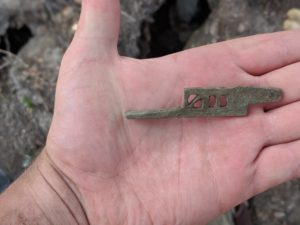
It was during these four weeks that some pretty neat stuff was found. I myself found various bits of bronze everyday objects that truly remind you that Romans were real people that existed outside of books. A bronze hairpin and elaborate looking key were probably my favorite discoveries. Various inscriptions where found by others. Perhaps the neatest thing, at least in my opinion, was found by one of the trench supervisors. He uncovered a small marble bust of a bearded male deity. I had a bit of a “I suddenly remembered my Charlemagne” moment when it was theorized to represent Dionysus and be the top of a herm. It was hard, at that point, not to recall Alcibiades’ supposed mutilation of the herms. Never before had Plutarch felt more real to me.
I would like to think the Classics Departments of Florida State University and Bryn Mawr College for giving me and other undergraduates such a wonderful opportunity. More information about the Cosa Excavations, including the sponsoring institutions, can be found here. Special thanks are also due to Prof. Smith and Prof. Joseph of Holy Cross for their support in my application to Cosa and for applications to various methods of funding
Classics & Chemistry major Chris Puntasecca ’19 to attend Stanford Medical School as a Knight-Hennessey Scholar
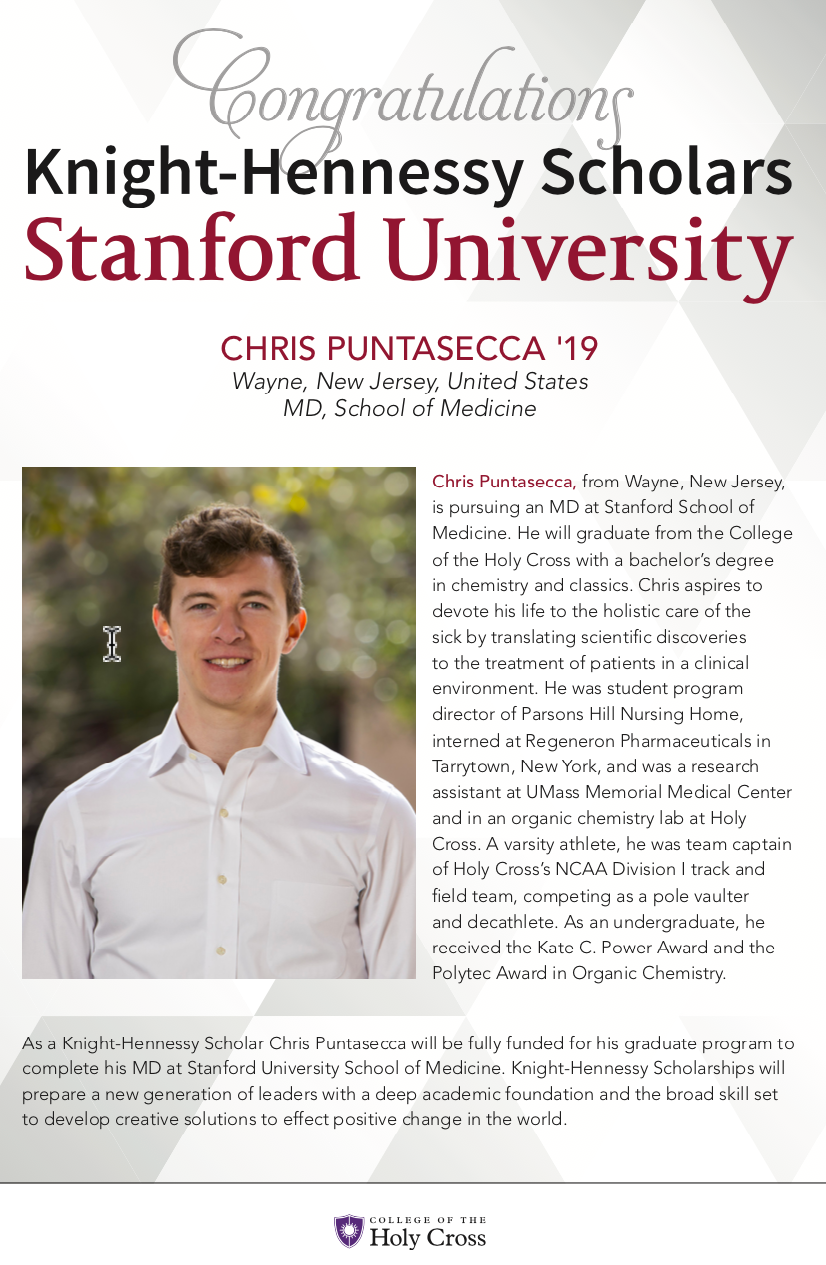
Seizing the opportunity for a semester in Rome
By Emma Powell ’20

“Fortes fortuna iuvat,” which translates to “Fortune favors the brave,” is the famous line from Pliny the Younger’s letter describing the events of the eruption of Mount Vesuvius. The sentiment of that line is the foundation on which, at least recently, I have tried to navigate my life. In deciding to study away in Washington, D.C. in the fall semester and abroad in Rome, Italy, this semester, I was extremely hesitant. In all honesty, I had a crippling fear of missing out on my beloved professors, classes, friends, and everything else that comes with my amazing life at Holy Cross. In the end, I decided to take advantage of both experiences, and I could not be happier with my decision. How could anyone regret living in Rome?
This semester I am studying at Temple University’s Rome campus. Every morning, I walk from my apartment located directly next to the Vatican, over the Tiber River to school. When I walk across the Tiber I think about the importance it played in Ancient Rome. The river played an important role in trade and the founding story of Rome, but also reminds us that nature cannot be controlled, as it often flooded. At the school my courses include Greek, Latin, Italian, Museum History, and of course Roman History.
My coursework comes alive when I walk around Rome. When I learn about the set up of the Roman Forum, I can actually walk over and retrace the steps of Triumphal Procession. When we read Ovid’s “Apollo and Daphne” passage in the Metamorphoses, I can go to the Villa Borghese and look at Bernini’s neo-classical sculpture inspired by the passage. Everyday, I am living in the physical world of what I study in my Classics classes at Holy Cross.
By far, my favorite spot in Rome is the Aqueduct Park. Located at the end of the metro, this park holds remains of the Aqua Felix and the Aqua Claudia. With a mix of ancient and more modern aqueducts, this park reminds me of the power of time. I like to sit in the park with a group of my friends, picnic, and watch the sunset go down behind the aqueduct. It is overwhelming and comforting all at once. These conflicting ideas of nature vs. man, permanence vs. fleetingness overcome me. This park and my experience in Rome remind me to be brave. Living in Rome has allowed me the courage to seize every opportunity to travel, to learn, and to experience new things. Classics in general reminds me of my humanity and Rome has only solidified this.
Fortune favors the brave, but bravery does not have to be a grand heroic gesture. Bravery can simply be taking a chance. I am beyond grateful I took a chance on going abroad.
A trilingual exchange in Beijing
By Vincent Crotta ’19
As a Classics major in China, I didn’t really expect to use much Latin or Greek — and for the most part I was right.
However, I recently had a really cool experience with one of my Chinese teachers. Here in Beijing the building we use for classes has a lot of unused classrooms, and I had asked my cultural adviser here if I could use one of these unused classrooms for painting.
She was kind enough to say “yes,” and so for the last few months I had been using an old classroom to paint and I had hung up some of the finished paintings on the walls. One of the paintings I had finished (pictured at right) was inspired by the song “Rändajad,” which is by the Estonian group Urban Symphony. One on my teachers came into the room and asked about the painting.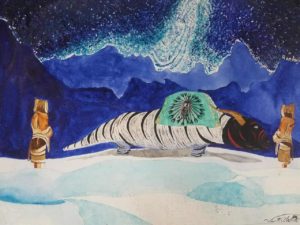
As I was explaining it to her in Chinese, she asked about the meaning of the name of the band. I told her the band was called Urban Symphony. She asked what the word “urban” meant, and I explained in Chinese that “urban” refers to the setting of a city and comes from the Latin word urbs, urbis, meaning “city.”
My teacher then asked if the words “rural” and “suburban” also had Latin roots, and I said that they also did. She was very excited to learn three new words in English and then in Latin, and I was happy to be able to teach her something new.
Greetings from Nijmegen, NL, where the nomina (and omina?) of many Romans lurk
Prof. Thomas Martin sends a dispatch from his trip to the Netherlands over October break.
About the same population as Worcester, Nijmegen is said to be the oldest city in the Netherlands, dating back to the late first/early second centuries CE. I don’t believe there are too many long-term Roman settlements north of here, so this is close to the northernmost edge of Roman expansion on the northwestern edge of the European continent (not including Great Britain).
Nijmegen is said to be from the Roman name given to this settlement of Romans and ancient Belgians in the very early second century, which was Ulpia Noviomagus Batavorum. Noviomagus is said to be a Romanization of a Celtic phrase meaning “New Market” or perhaps “New Field.”
Not too far from the neighborhood where I am staying at the house of my daughter and her family, there is a collection of streets running along the side of a hill that stands parallel to a tributary of the Waal River, one of the two rivers in Nijmegen and itself a tributary of the Rhine River. These streets boast striking (for Classicists!) names. Photos of a selection of the streets’ signs and appearances are below.
The first photo shows the street sign for what would have been a cool address for hippie Latinists in San Francisco and Berkeley in the 1970s. (I won’t reveal how I know that there were hippie Latinists in San Francisco and Berkeley in the 1970s!)
The second photo shows the street associated with the first street sign. It seems fitting, given the often acerbic tone of author whose name is attached to the street, that it is a “Private Way.”
The third photo shows a street sign designating the “plaza” or “area” of a particularly dyspeptic early Roman Emperor. Given his distinctly-less-than-warm-and-fuzzy reputation, its seems ironic, as shown in the fourth photo, that his “area” is a inviting, grassy park in which children play soccer!
The fifth photo shows a street sign associated with a Roman Emperor said to have been more personable. It is then fitting, in his case, that his street (the sixth photo) also flanks an area where children play.
The seventh photo shows in the distance the narrow branch of the river beyond the hill where these streets lie, in a district perfectly suited for watching with care the traffic on the water, to try to see if it was bringing friendly visitors or hostile raiders.


